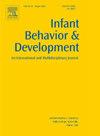婴儿与照顾者互动时声音反应的早期发育变化。
IF 1.9
3区 心理学
Q3 PSYCHOLOGY, DEVELOPMENTAL
引用次数: 0
摘要
目的:本研究以3、6、9和12个月的韩国婴儿为研究对象,探讨自然家庭环境下婴儿声音反应的发展轨迹以及婴儿与照顾者之间声音互动的时间特征。方法:使用LENA录音机收集3、6、9和12个月婴儿一天的家庭录音。深入分析了LENA记录的20个5分钟片段,这些片段显示了由LENA自动分析确定的最高会话次数。通过婴儿发声反应、发声反应潜伏期和重叠发声来研究婴儿与照顾者互动时发声的时间特征。结果:不同年龄组的儿童在成人言语后的声音反应比例存在差异。具体而言,3个月时比例最高,6个月和9个月时明显下降,12个月时略有增加。婴儿的声音反应延迟随着年龄的增长而增加,表明婴儿年龄越大,反应延迟越长。重叠发声的比例在3、6、9月龄时基本一致,但在12月龄时明显下降。结论:这些发现突出了婴儿在出生后第一年的声音互动的明显变化。虽然分析是横断面的,但观察到的模式表明,随着婴儿年龄的增长,声音反应的时间和结构发生了发育变化。本研究表明,婴儿会根据照顾者的言语来调整他们的声音互动,这可能反映了一个逐渐学习会话协调的过程。本文章由计算机程序翻译,如有差异,请以英文原文为准。
Early developmental changes in infants’ vocal responses in interactions with caregivers
Objectives
The study aimed to explore the developmental trajectory of infants’ vocal responses and the temporal characteristics of vocal interactions between infants and caregivers in natural home environments, focusing specifically on Korean infants aged 3, 6, 9, and 12 months.
Methods
One-day home recordings were collected using a LENA recorder at ages 3, 6, 9, and 12 months for each infant. In-depth analyses of the LENA recordings were conducted on 20 5-minute segments that showed the highest conversational turn counts, as determined by the LENA automated analysis. The temporal characteristics of infant vocalizations during interactions with caregivers were examined through infant vocal response, vocal response latency, and overlapping vocalizations.
Results
The results indicated that the proportion of infant vocal responses following adult speech differed across age groups. Specifically, the highest proportion was observed at 3 months, with a noticeable decrease at 6 and 9 months, and a slight increase at 12 months. Infant vocal response latency increased with age, indicating longer response delays as infants got older. The proportion of overlapping vocalizations was consistent among 3, 6, and 9-month-olds but decreased significantly at 12 months.
Conclusion
These findings highlight distinct changes in infant vocal interactions during the first year of life. Although the analysis was cross-sectional, the observed patterns suggest developmental changes in the timing and structure of vocal response as infants age. This study indicates that infants adapt their vocal interactions in response to caregivers’ speech, which may reflect a gradual learning of conversational coordination.
求助全文
通过发布文献求助,成功后即可免费获取论文全文。
去求助
来源期刊

Infant Behavior & Development
PSYCHOLOGY, DEVELOPMENTAL-
CiteScore
4.10
自引率
4.80%
发文量
94
期刊介绍:
Infant Behavior & Development publishes empirical (fundamental and clinical), theoretical, methodological and review papers. Brief reports dealing with behavioral development during infancy (up to 3 years) will also be considered. Papers of an inter- and multidisciplinary nature, for example neuroscience, non-linear dynamics and modelling approaches, are particularly encouraged. Areas covered by the journal include cognitive development, emotional development, perception, perception-action coupling, motor development and socialisation.
 求助内容:
求助内容: 应助结果提醒方式:
应助结果提醒方式:


